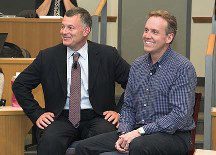Leadership Digest Editor’s Note: William Lauder, W’83 Executive Chairman, The Estée Lauder Companies Inc. and Leadership Advisory Board Member returns this spring to teach the popular MGMT 892 – Decision Making in the Leadership Chair. The class is open to second-year MBAs through a competitive application and selection process of highly qualified students and attracts an engaging and diverse list of guest speakers. The purpose of MGMT 892 is to promote the development of future business leaders by fostering conversations between students and experienced leaders. Wharton Magazine recently published an article on the class, included below.
Leadership Lessons From the C-Suite
By Matthew Brodsky
Posted October 24th, 2013
An experimental class delivers a star-studded educational experience on leading the enterprise.
Professor William Zucker’s real estate development class some 30 years ago stuck with William P. Lauder, W’83. Though Lauder didn’t go into real estate— he’s executive chairman of the Estée Lauder Companies— he remembers the power of sitting in a classroom each week for three hours and having direct interaction with industry leaders. In the case of Zucker’s class, Lauder the undergrad sat in a graduate class and presented to real-world developers. Lauder hoped to bring today’s Wharton students the same experience. His topic is leadership.
The class—Management 892: “Decision-Making in the Leadership Chair”—became a reality in spring 2013. About 40 second-year MBA students were chosen out of hundreds of applicants to participate.
They were treated to seven weeks of unique leadership education and to a star-studded class. Lauder himself taught the first session (topic: the role of the chief executive). In subsequent weeks, he passed the lectern to Lauren Zalaznick, executive vice president at NBCUniversal (leading creativity); Ed Breen, chairman of Tyco International (leading through restructuring); James D. Robinson, managing partner of RRE Ventures (leading a portfolio of companies); Arthur Sulzberger Jr., chairman and publisher of The New York Times (leading during transformation); Richard Parsons, former chairman of Citigroup and AOL Time Warner (leading the board); and William Clay Ford Jr., executive chairman of Ford Motor Co. (leadership transitions).

Lauder pulled together such a cast through a two-part planning process. He considered which business leaders would be interesting to have speak given the challenges they faced, and which would be compelling given their expertise in leading a certain type company. He also decided which core leadership themes needed to be covered and who could address them.
“It was sort of an iterative process; it’s kind of hard to say which came first,” Lauder recalls.
In describing what the guest speakers brought to their talks in a Wharton Blog Network post, Michael Useem, the William and Jacalyn Egan Professor of Management, wrote: “In recounting their personal experiences navigating through significant challenges, the guest instructors stressed the importance of balancing both head and heart in their leadership decisions; reconciling the competing interests of employees, customers, regulators, investors, suppliers and shareholders; and bringing both personal leadership agility and a deep understanding of the business to the corner office.”
Along with Useem, faculty members Mauro Guillen, Adam Grant and David Wessels also participated.
The result was an increasingly dynamic course that featured a combination of guest lecturers; student presentations and feedback; student blogging; and interactive dialogue among faculty, students, Lauder and the guests. The Q-and-A didn’t stop in the classroom. Each week featured a dinner. For the first and final week, all students were invited, and each week in between, students could attend a dinner with their guest leader of choice.
Out of the intense experience, Lauder is not able to name one favorite moment. For him, though, watching the students develop and learn before his eyes was worth it.
“Seeing how the students responded, seeing how they grasped some of the concepts and how they would apply the concepts over time, and the quality of their questions as the class progressed from one to the other was actually very interesting,” he says.
Ultimately, Lauder hopes the experience will be a highlight of the students’ two years at Wharton, something they can tap for wisdom during the career years ahead. He also hopes to inspire other alumni to collaborate with Wharton to create a new, similar course.
“My other goal is that there’ll be more people who will want to teach classes like this so that instead of only being 40 students out of a class of over 800 who will have this opportunity, maybe there can be more,” he says.


